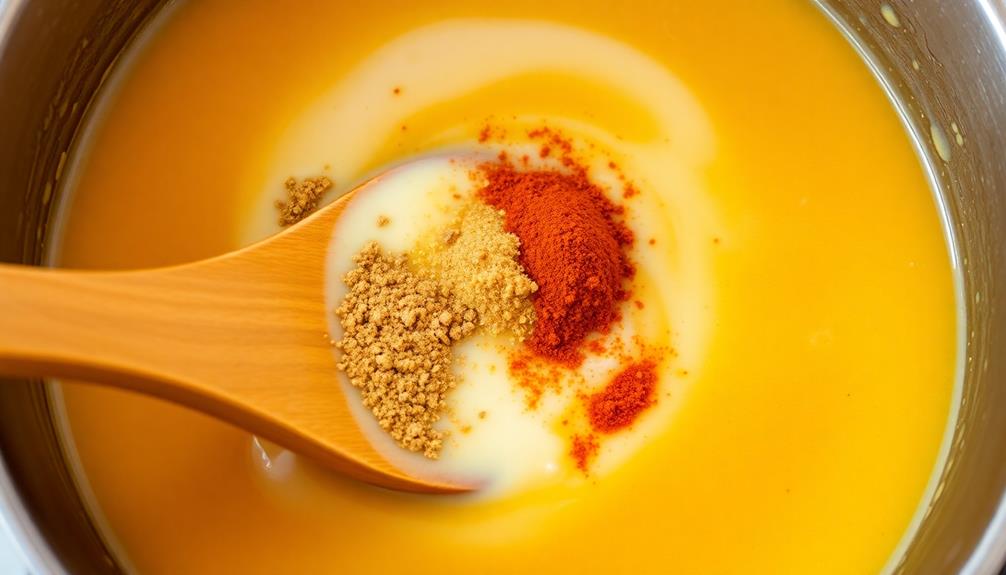Mchuzi Wa Samaki, the celebrated Tanzanian fish curry, takes you on a flavorful journey through East African culinary traditions. This vibrant dish blends aromatic spices, creamy coconut milk, and fresh local fish, resulting in a rich, complex flavor profile. Its roots trace back to diverse cultural influences, showcasing Tanzania's gastronomic heritage. From preparation to serving, the dish's simplicity yet depth will captivate your senses – and there's much more to discover about this iconic Tanzanian cuisine. You can also explore other Tanzanian culinary wonders, like the famous Zanzibar pizza recipe, which incorporates a unique blend of Indian, Arab, and Swahili flavors. These dishes are a true reflection of Tanzania’s history and the diverse influences that have shaped its cuisine. Whether you’re enjoying Mchuzi Wa Samaki or learning how to make Zanzibar pizza, you’ll experience the vibrant and delicious tapestry of East African cooking.
Key Takeaways
- Tanzanian fish curry, known as Mchuzi Wa Samaki, has culinary roots influenced by diverse cultural exchanges, reflecting the country's rich gastronomic heritage.
- The dish combines coconut milk, aromatic spices, and fresh fish fillets to create a rich and creamy flavor profile.
- Mchuzi Wa Samaki is traditionally served with staple accompaniments like ugali or fluffy steamed rice, reflecting its importance in Tanzanian cuisine.
- The preparation involves searing the fish, adding spices and coconut milk, and simmering gently to allow the flavors to meld.
- The dish celebrates Tanzania's vibrant culinary traditions, offering a delightful balance of comfort and exotic flavors.
History
Tanzanian fish curry has its roots in the country's diverse culinary traditions. Over the centuries, the coastal regions of Tanzania have been influenced by Arab, Indian, and European traders, who've all left their mark on the local cuisine.
The use of spices like coriander, cumin, and turmeric in the curry is a testament to these cultural exchanges. The dish has also evolved to incorporate locally-sourced ingredients, such as coconut milk, which adds a rich, creamy texture to the curry.
The preparation of Tanzanian fish curry is a time-honored ritual, passed down through generations, reflecting the country's rich gastronomic heritage. Today, it remains a beloved staple in Tanzanian households and a cherished part of the nation's culinary identity.
Recipe
Tanzanian fish curry is a flavorful and aromatic dish that combines the rich flavors of coconut milk, aromatic spices, and fresh fish. This curry is a staple in Tanzanian cuisine, often enjoyed with ugali, a traditional maize-based staple.
The key to a delectable Tanzanian fish curry lies in the careful selection and blending of spices. The interplay of fragrant spices, such as cumin, coriander, and turmeric, creates a depth of flavor that perfectly complements the tender fish.
- 1 lb white fish fillets (such as tilapia or cod), cut into chunks
- 1 onion, diced
- 3 cloves garlic, minced
- 1 tablespoon grated ginger
- 1 teaspoon ground cumin
- 1 teaspoon ground coriander
- 1 teaspoon ground turmeric
- 1 teaspoon paprika
- 1 can (13.5 oz) coconut milk
- 1 cup water or fish stock
- 2 tomatoes, diced
- Salt and pepper to taste
- Chopped cilantro for garnish
In a large pot or pan, sauté the onion, garlic, and ginger over medium heat until fragrant and softened. Add the ground cumin, coriander, turmeric, and paprika, and cook for an additional minute to toast the spices.
Pour in the coconut milk and water or fish stock, and bring the mixture to a gentle simmer. Gently add the fish chunks and diced tomatoes, and let the curry simmer for 15-20 minutes, or until the fish is cooked through and the flavors have melded together.
To ensure the best results, use fresh, high-quality fish fillets and allow the curry to simmer gently to allow the flavors to develop. Serve the Tanzanian fish curry hot, garnished with chopped cilantro, and accompanied by a side of ugali or steamed rice.
Cooking Steps
First, gather your ingredients and equipment.
Next, chop the onions and tomatoes.
Then, add the fish to the pan, sprinkle in the spices, and pour in the coconut milk.
Simmer until the fish is fully cooked.
Step 1. Gather Ingredients and Equipment

To begin, you'll need to gather all the necessary ingredients and equipment for preparing this delectable Tanzanian fish curry.
You'll start with the protein – about 1 lb of firm white fish, such as tilapia or snapper, cut into chunks. For the aromatic base, you'll need an onion, garlic cloves, and fresh ginger, all finely chopped.
Don't forget the spices – curry powder, cumin, coriander, and cayenne pepper. You'll also need coconut milk, tomato paste, lemon juice, and a handful of fresh cilantro.
As for equipment, you'll require a large skillet or saucepan, a sharp knife, a cutting board, a spoon, and a spatula.
Once you have everything gathered, you'll be ready to start cooking this flavorful and authentic Tanzanian fish curry.
Step 2. Chop Onions and Tomatoes

Once you have gathered all the necessary ingredients, begin by chopping the onion and tomatoes.
Start with the onion – peel off the outer layers and discard them. Slice the onion in half lengthwise, then thinly slice each half. The thinner the slices, the better, as they'll cook down faster.
Next, tackle the tomatoes. Slice them in half horizontally, then dice them into small, even pieces. Aim for about a quarter-inch cubes. Work quickly to avoid the tomatoes releasing too much juice.
Toss the chopped onion and tomatoes together in a bowl, ensuring they're well mixed. This combination of aromatic onions and juicy tomatoes will form the base of your Tanzanian fish curry.
With the prep work done, you're one step closer to enjoying the rich, flavorful dish. Keep the chopped veggies close at hand, as you'll be adding them to the pan in the next step.
Step 3. Add Fish to Pan

With the onions and tomatoes ready, it's time to add the fish to the pan. Grab the pieces of tilapia or other white fish you've prepped and gently place them in the sizzling oil. Be careful not to overcrowd the pan – you want the fish to have enough room to brown and cook through evenly.
Sprinkle the fish with a pinch of salt and a few cracks of black pepper. Let the fish sear for 2-3 minutes per side, until it's opaque and flakes easily with a fork.
Once the fish has been seared, add the tomato mixture you prepared earlier. Stir to combine, ensuring the fish is fully coated in the aromatic sauce.
Bring the curry to a gentle simmer and let it cook for 10-12 minutes, until the sauce has thickened and the flavors have melded. Taste and adjust seasonings as needed, adding more salt, pepper, or a squeeze of lemon juice to brighten the dish.
Serve the Tanzanian fish curry hot, over a bed of steamed rice.
Step 4. Add Spices and Coconut Milk

Next, add the spices to the curry. Sprinkle in the cumin, coriander, paprika, and cayenne pepper. Stir the spices into the fish and onions, allowing the aromas to bloom. The vibrant hues will infuse the dish with warmth and depth of flavor.
Now, pour in the coconut milk. Stir it in gently, being careful not to break up the fish. The rich, creamy coconut milk will create a luxurious sauce that coats the tender fish. Allow the curry to simmer, letting the flavors meld together.
As it simmers, the curry will thicken slightly. Taste and adjust the seasoning as needed, adding more salt or spices to suit your preference. The bright, aromatic spices should balance perfectly with the cooling coconut milk.
When the curry has reached your desired consistency, it's ready to serve. Ladle the fragrant Tanzanian fish curry over steaming rice or ugali, the traditional stiff cornmeal porridge.
Get ready to be transported to the vibrant flavors of East Africa.
Step 5. Simmer Until Fish Is Cooked

Reduce the heat to medium-low and allow the curry to simmer gently. This step is crucial, as it allows the flavors to meld together and the fish to cook through.
Gently simmer the curry for 10-15 minutes, stirring occasionally, until the fish is cooked and flakes easily with a fork. Be careful not to overcook the fish, as it can become dry and tough.
As the curry simmers, keep an eye on the consistency. If it becomes too thick, add a bit more coconut milk or water to thin it out. Conversely, if it's too thin, allow it to simmer a bit longer to help the sauce reduce and thicken.
Season with additional salt and pepper to taste.
The fish should be tender and infused with the aromatic spices and creamy coconut milk. Once the fish is cooked through, remove the pan from the heat and serve the Tanzanian fish curry hot, garnished with fresh cilantro or lime wedges, if desired.
Enjoy the rich, flavorful dish.
Final Thoughts
The Tanzanian Fish Curry is a flavorful and aromatic dish that celebrates the vibrant culinary traditions of Tanzania. It's a perfect balance of spices, coconut milk, and tender fish that'll transport your taste buds to the warm shores of East Africa.
Don't be intimidated by the long list of ingredients – the preparation is straightforward, and the end result is well worth the effort.
Once you've simmered the fish to perfection, take a moment to savor the rich, creamy sauce and the melt-in-your-mouth texture of the fish. This dish is a true delight for the senses, with its fragrant aroma and vibrant colors.
Serve it with a side of fluffy steamed rice or chapati, and you've got a meal that's fit for a Tanzanian feast.
Whether you're looking to expand your culinary horizons or simply enjoy a comforting, flavorful dish, the Tanzanian Fish Curry is a must-try. Dig in and let the flavors transport you to the heart of East Africa.
Frequently Asked Questions
What Spices Are Traditionally Used in Tanzanian Fish Curry?
Traditionally, you'd find a blend of aromatic spices in Tanzanian fish curry, including cumin, coriander, turmeric, chili peppers, and ginger. These spices work together to create a rich, flavorful, and slightly spicy curry.
How Long Can the Leftover Tanzanian Fish Curry Be Stored?
Your leftover Tanzanian fish curry can be stored safely in the refrigerator for up to 3-4 days. Be sure to store it in an airtight container and reheat it thoroughly before serving.
Can the Tanzanian Fish Curry Be Made With Other Types of Fish?
Yes, you can make the fish curry with different types of fish. The dish is quite versatile, so feel free to experiment with salmon, tilapia, or even shrimp to suit your preferences and the available ingredients.
What Are the Common Accompaniments Served With Tanzanian Fish Curry?
You can serve the fish curry with a variety of accompaniments, such as rice, chapati, ugali, or even roasted potatoes. These starchy sides help soak up the flavorful curry sauce and balance the richness of the dish.
Is the Tanzanian Fish Curry Suitable for Vegetarians or Vegans?
Tanzanian fish curry is not suitable for vegetarians or vegans, as it's made with fish. However, you could try making a vegetarian or vegan-friendly version by substituting the fish with tofu, tempeh, or a variety of vegetables.










